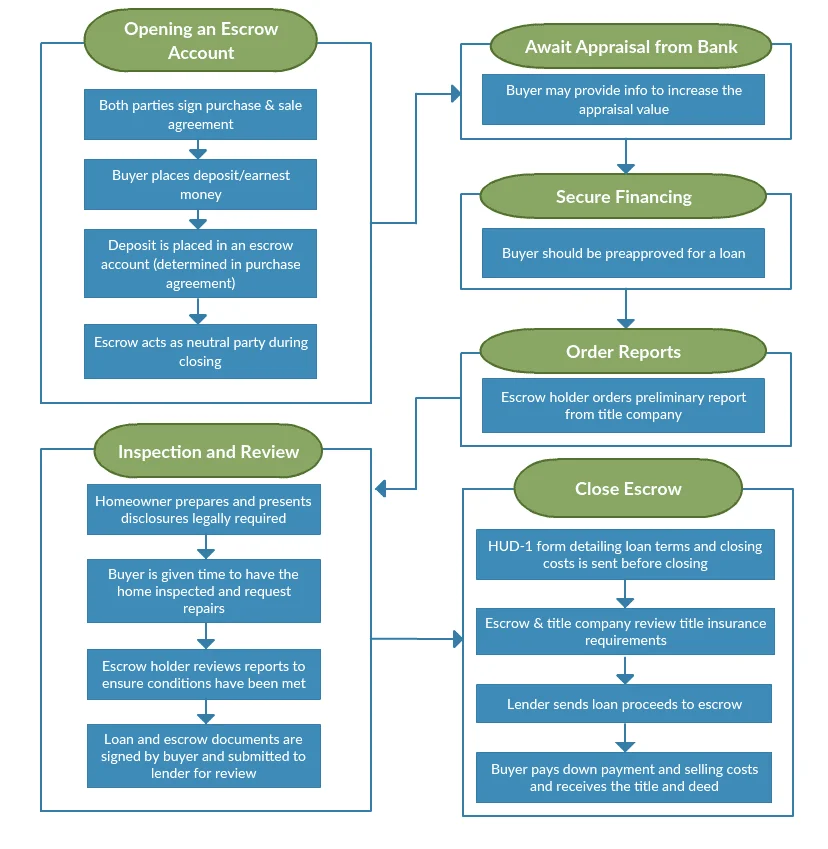Your hard work has paid off! You’ve made repairs and upgrades, staged your home, crafted the perfect marketing strategy, and found an interested buyer who is ready to begin closing and enter the escrow process. But what is an escrow, how long does it take, and what does it actually mean to “close escrow“?
The escrow process may be complex, but it doesn’t have to be overwhelming. Read on to learn what happens during escrow, so you’re not in the dark while you wait to receive the keys to your new home.
What is the Escrow Process?
Escrow is a common part of most real estate transactions. The escrow process introduces a neutral third-party — an “escrow agent” — that collects earnest money from the buyer.
The agent holds these funds, important documents and the property itself “in escrow” while the details of the deal are worked out. Once the seller and buyer agree on the terms of the sale, the transaction is completed and escrow is closed.
What Happens During Escrow and When Does It Start
The escrow process begins when both the seller and buyer sign a purchase agreement. An escrow agent then gathers what’s known as “earnest money” from the buyer and places it in an escrow account, the details of which are laid out in the purchase agreement. Usually, the earnest money is a small percentage of the total sale price of the home.
Once the escrow agent collects the money, the seller removes the property from the market. Now the money and property will be held securely in escrow through the closing process.
Many other moving parts come together during this time, such as:
-
- Completing financing
- Home inspection
- Completion of repairs or other requests
- Title report ordered by the escrow holder
- Document review
Once all the T’s are crossed and I’s dotted, the buyer makes an agreed-upon down payment and pays any selling costs. Now the title can be transferred to the buyer. When the sale is complete, escrow is closed.
Escrow Process Flow Chart
Take a look at the escrow process flow chart below to get a better understanding of how it works from start to finish.

How Long Does Escrow Take?
In most cases, the escrow process takes between 30 and 50 days. However, escrow can take much longer under certain circumstances, such as a home inspection that triggers negotiations about repairs or sale price. Issues with financing may also extend the escrow process.
How to Close Escrow in California
The escrow process — and the laws that govern it — vary from state to state. In California, the process has a few unique features, including that the title company remains separate from the escrow company. This and other complications mean that escrow typically takes a bit longer in California, sometimes up to 60 days from start to finish.

In fact, in other states, the word “escrow” may not even be used as it is in California. It’s important to understand how escrow works in your state before buying or selling a home.
Given all the moving parts, documents, reports, and steps that must be completed in order to close escrow, it’s easy to see how the long process of escrow may extend the time it takes to close a home sale.
Want to Bypass the Escrow Process?
While all home sales require a clear title, HomeGo can complete the title transfer in as few as seven days. If you really can’t wait, HomeGo allows you to bypass the escrow process altogether because we purchase homes with our own money, no need to wait for financing approval.
Plus, because HomeGo pays cash and doesn’t require home inspections, you don’t even have to worry about the sale falling through. With the time savings and lack of worry, it’s a true win-win.




